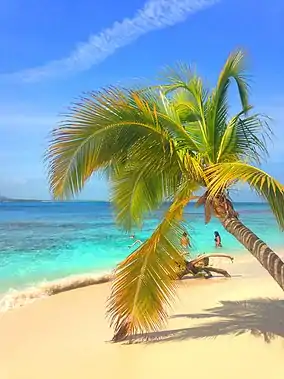
The Central-Western Region is one of the 10 administrative regions in which Venezuela was divided for its development plans; it comprises the states of Falcón, Lara, Portuguesa, and Yaracuy.

History
The area was first explored in 1499 by Juan de la Cosa and Américo Vespucio, as part of an expedition supervised by Alonso de Ojeda. In 1811, when Venezuela declared its independence, Coro remained faithful to the Spanish Crown and merged with the Province of Maracaibo, until Fernando VII decreed the creation of the Province of Coro in 1815.
In 1879, together with Lara and Yaracuy, minus the Department of Nirgua, the Falcon State became part of the Western Northern State. Between 1881 and 1890 it formed with Zulia the State of Falcon-Zulia. In 1891 it appears again as an independent state with the name of Falcon. In the 1960s the current administrative region was created to give the region more economic dynamism.
Geography
It is bordered to the north by the Caribbean Sea; to the east by the states of Carabobo and Cojedes, both belonging to the Central Region; to the south by the state of Barinas, in the Andean Region; and to the west by the state of Trujillo, which is also part of the Andean Region, as well as the state of Zulia, which is the only state that constitutes the so-called Zulian Region.
It has an area of 66900 km2, which represents 7.3% of the national total.

Weather
-Semi-arid, tropical, dry with high temperatures and low rainfall (BSh): located north of the Sierra de San Luis in Falcón and the Paraguaná Peninsula, in the Carora and Barquisimeto Depressions.
- Tropical Rainforest Climate(Aw): is located in Yaracuy.
- Tropical Rainforest Climate of Sabana (Aw): located in the plains of Portuguesa (Zamora, 2007)
Demographics
All the states in this region, with the exception of Lara, have negative migratory balances, due to socio-economic conditions. Lara and Yaracuy are the states with the largest urban populations in the region, followed by Falcón. However, this state has a quarter of its population in rural conditions. In the state of Portuguesa, more than a third of its population lives in rural areas.
The entity with the largest number of inhabitants is Lara, which is twice as large as the second most populous state. There are 4,155,062 inhabitants in the region, distributed over 65,900 square kilometres, or 7.19 per cent of the national territory. Among its main cities are Barquisimeto, Punto Fijo, Acarigua, San Felipe, among others.
The region has a total population of 4,231,060 inhabitants which are mostly concentrated in the states of Lara and Falcon. The most populated cities are Barquisimeto, Punto Fijo, Guanare, Coro and Acarigua.
Economy
The economy is varied, but among the main resources are tourism, some oil and agricultural activities among others, an example of these tourist attractions and oil activities and others are the Morrocoy National Park (in Falcon), Basilica Menor Nuestra Señora de Coromoto (in Guanare), and the Cardon and Amuay refineries (also in Falcon). As well as the agricultural production where they derive items such as vegetables and so on.
Activities
They are dedicated to self-consumption agriculture, their crops are: potatoes, apples and peaches extracted from the Esperanza. Their products are agricultural exports from the Coma Yagua Valley: vegetables, tomatoes, onions, aubergines and cucumbers. Also coffee, maquilas and fruits for juice are cultivated.
Gallery
 Cattle in Lara State
Cattle in Lara State Cayo Sombrero, Morrocoy National Park
Cayo Sombrero, Morrocoy National Park
 Los Frailes, Portuguesa State
Los Frailes, Portuguesa State Estadio Metropolitano, Lara State
Estadio Metropolitano, Lara State